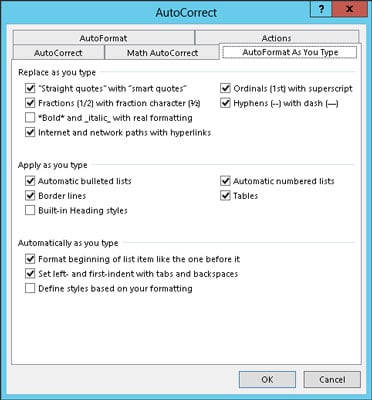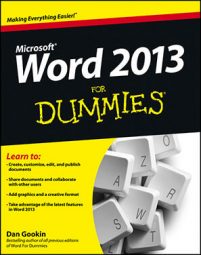Part of the AutoCorrect function in Word 2013 is a feature named AutoFormat. Whereas AutoCorrect is used to fix primarily typos and common spelling boo-boos, AutoFormat is used to fix formatting fumbles.
AutoFormat controls some minor text formatting as you type. The settings are visible in the AutoFormat dialog box.

To display that dialog box, heed these steps:
-
Click the File tab.
-
On the File screen, choose Options.
The Word Options dialog box appears.
-
Select Proofing from the left side of the window.
-
Click the button labeled AutoCorrect Options.
-
Click the AutoFormat As You Type tab in the AutoCorrect dialog box.
This part of the dialog box is where all the AutoFormat options dwell. Turning an option off or on is as easy as removing or adding a check mark.
The best way to demonstrate the AutoFormat-as-you-type concept is to have a Word document on the screen and then type examples. Note that these samples demonstrate only a few of the things AutoFormat can do.
Smart quotes
The quote characters on the keyboard are tick marks: " and '. AutoFormat converts them into the more stylish open and closed curly quotes. Type hither:
He said, "Yes, I’m being honest. I really do love you, but the monster is coming and you broke your ankle, and I figured that you'd understand."
Both the single and double quotes are properly used and converted.
Real fractions
You can format a fraction by typing the first value in superscript, the slash mark, and then the second value in subscript. Or you can let AutoFormat do it for you. Here’s an example:
I spend twice the time doing 1/2 the work.
The characters 1/2 are converted into the single character 1/2. This trick works for some, but not all, common fractions. When it doesn't work, use the superscript/subscript trick.
Hyperlinks
Word can underline and activate hyperlinks that are typed in your document, such as
I’ve been to <a href="http://www.hell.com">http://www.hell.com</a> and back.
The website is automatically underlined, colored, and turned into an active web page link for you. (You have to Ctrl+click to follow the link.)
Ordinals
You're guessing wrong if you think that ordinals are a baseball team or a group of religious leaders. They're numbers that end in the letters st, nd, or rd, as this line demonstrates:
There were two of us in the race; I came in 1st and Barbara came in 3rd.
Word automatically superscripts ordinal numbers, making them look oh-so-spiffy.
Em dashes
An em dash is the official typesetting term for a long dash, longer than the hyphen (or its evil twin, the en dash). Most people type two hyphens to emulate the em dash. Word fixes that problem:
A red one is a slug bug--not a punch buggy.
As you type the--(dash-dash), AutoFormat replaces it with the official em dash character.
-
The keyboard shortcut for typing an em dash is Ctrl+Alt+minus sign, where the minus sign is the minus key on the numeric keypad.
-
The keyboard shortcut for typing an en dash is Ctrl+minus sign.
-
The en dash is approximately the width of the letter N. Likewise, the em dash is the width of the letter M.

